As a chef at Food And Meal, I’m always seeking out new flavor adventures to share with our readers. Lately I’ve become enthralled with the idea of creating a spicy monkfish stew, a dish that promises warmth and comfort with a touch of exotic flair.
You see, I grew up in a small fishing village, where seafood stews made from the daily catch offered a taste of home. The chunks of tender fish, soaked in a broth bursting with herbs, chili heat, and tomato sweetness, never failed to soothe and satisfy.
Now at Food And Meal, memories of that aromatic, vibrant stew have filled me with inspiration. I’m especially drawn to the idea of using meaty monkfish, as its texture seems perfect for soaking up spices. And I can’t resist amping up the heat level and adding my own creative twist.
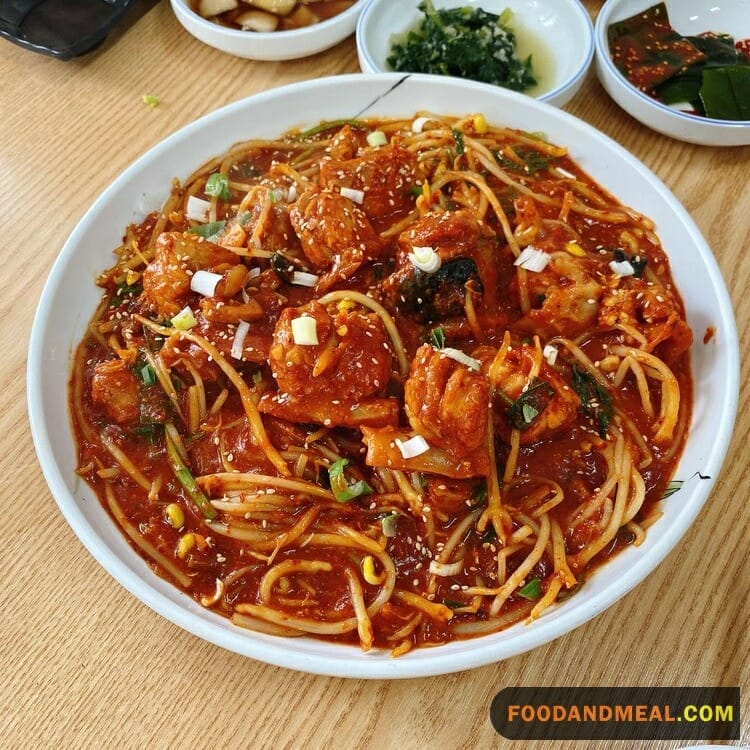
Spicy Monkfish Stew Korean Recipe
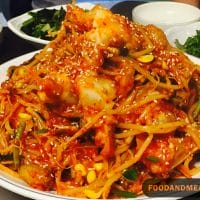
SPICY MONKFISH STEW
Ingredients
- 2 tablespoons doenjang or gluten-free doenjang
- 1 tablespoon gochujang or gluten-free gochujang
- 1 tablespoon gochugaru
- Salt
- 6 cups Anchovy Stock (here), or store-bought seafood broth
- 1 small zucchini, cut into 2-inch slices
- 1 small sweet onion, sliced
- 1 small daikon, cut into 2-inch pieces
- 5 ounces fresh shiitake mushrooms, thinly sliced
- 1 to 1 1/2 pounds monkfish, cut into 2-inch chunks
- 1 package of mung bean or sweet potato noodles, cooked according to the package directions
- 1 scallion, chopped, for garnish
Instructions
- In a stockpot, mix together the doenjang, gochujang, gochugaru, a pinch of salt, and the anchovy stock and set the pot over medium-high heat. Once the seasonings are dissolved in the stock, add the zucchini, onion, daikon, and mushrooms and bring up to a boil. Reduce the heat to low and simmer for 10 minutes.
- Add the monkfish and simmer gently for about 15 minutes, or until the fish is cooked through.
- To serve, divide the noodles among 4 large soup bowls and ladle the stew over the noodles. Garnish each serving with scallions.
Video
Notes
Nutrition
© Food And Meal
This website provides approximate nutrition information for convenience and as a courtesy only. Nutrition data is gathered primarily from the Spoonacular Database, whenever available, or otherwise other online calculators.
Spicy Monkfish Stew: Pressure Cooker Method
To create a flavorful monkfish stew, start by cleaning, deboning, and cutting the monkfish into bite-sized pieces. Prepare the vegetables and other ingredients as directed in the original recipe. In a pressure cooker set to ‘sauté,’ drizzle oil and cook garlic, ginger, and onions until translucent. Add monkfish, stirring to prevent sticking, then introduce vegetables, spices, and sauces after 2-3 minutes. Pour in stock or water, secure the lid, and cook on ‘high pressure’ for 15 minutes. Allow a natural pressure release for 10 minutes, then manually release any remaining pressure. Switch to ‘sauté’ mode to simmer if needed, adjusting consistency and seasoning. Serve the piping hot stew in bowls, garnished with fresh herbs or green onions, alongside steamed rice or noodles.
Cooking Tips for Spicy Monkfish Stew
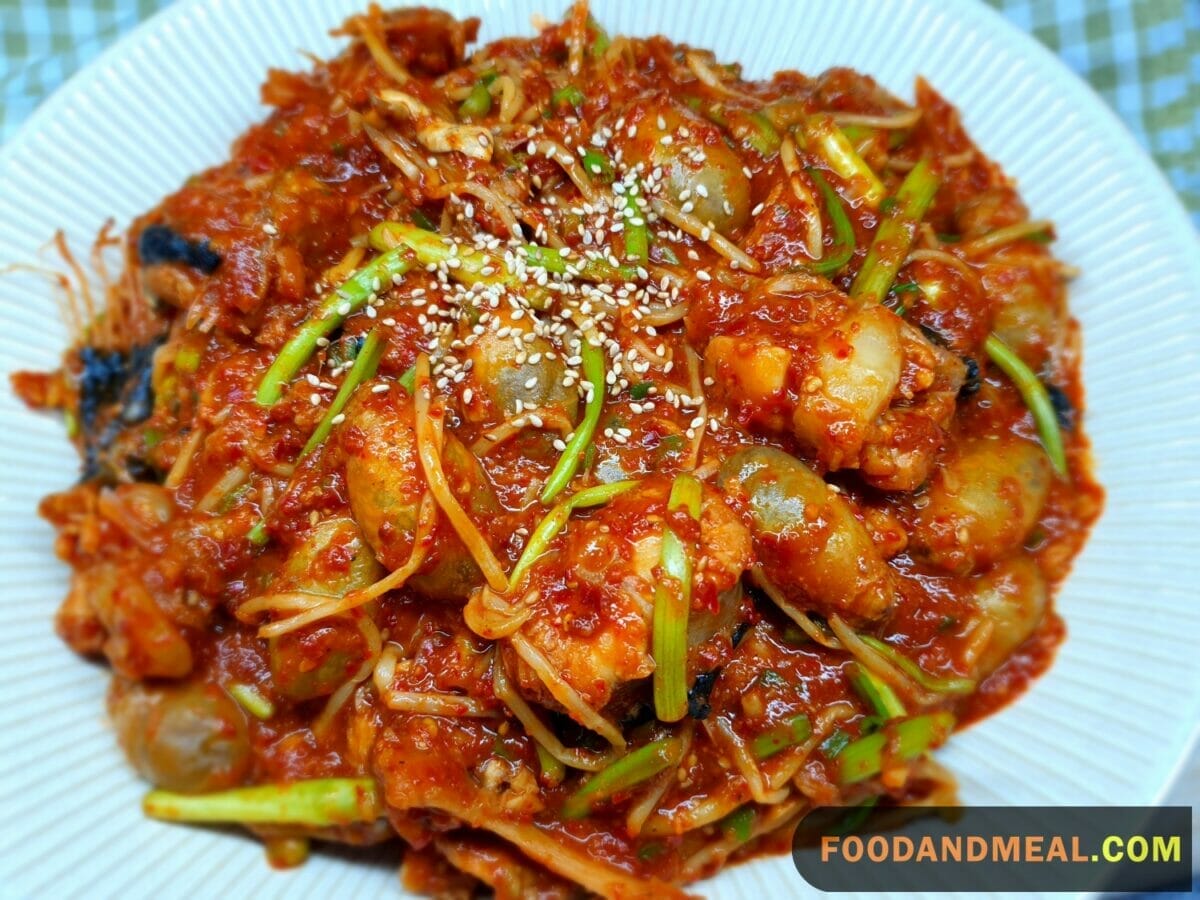
Serving Suggestions for Spicy Monkfish Stew
As I prepare to make this Spicy Monkfish Stew for the first time, I feel a thrill of eager anticipation. My mind fills with fond memories of the seafood stews from my childhood, as I hope to recreate some of that warming comfort and nostalgia in my own kitchen.
When handling the monkfish, I’ll take care to remove any membranes and trim off any dark red flesh, so my finished stew has the clean, bright flavors I’m envisioning. I’m looking forward to experimenting with my blend of spices and aromatics to complement the sweet tomato base.
My main goal is infusing the chunky fish pieces with spice and herb flavor as they gently simmer. I may start with small amounts of chili powder and red pepper flakes at first, adding more fiery punch if needed later on. As the stew’s enticing aroma fills my kitchen, I know a soul-soothing meal is close at hand.
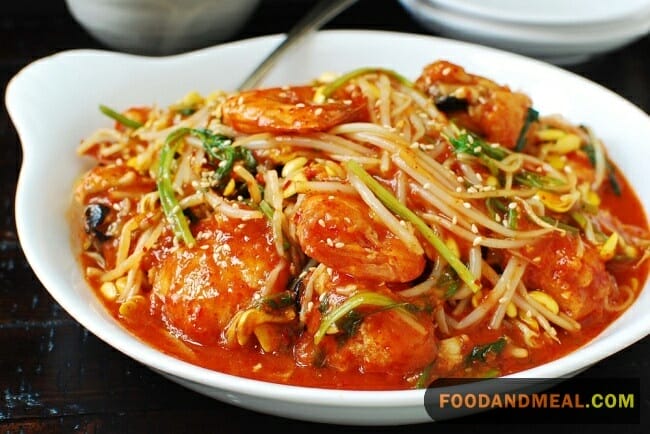
Envision a fusion of flavors with the robust Yakimiso Ramen or indulge in the comforting embrace of a bowl of Tonkotsu Ramen. For a harmonious blend, savor the stew alongside Teriyaki Salmon, balancing sweet and savory notes, or venture into a seafood extravaganza with Wok Fried Crab. Explore the bold side with the fiery Schezwan Noodles, creating a symphony of diverse and satisfying tastes. These curated suggestions promise to elevate your dining experience, providing a feast of textures and flavors alongside the Spicy Monkfish Stew.
FAQs: Spicy Monkfish Stew
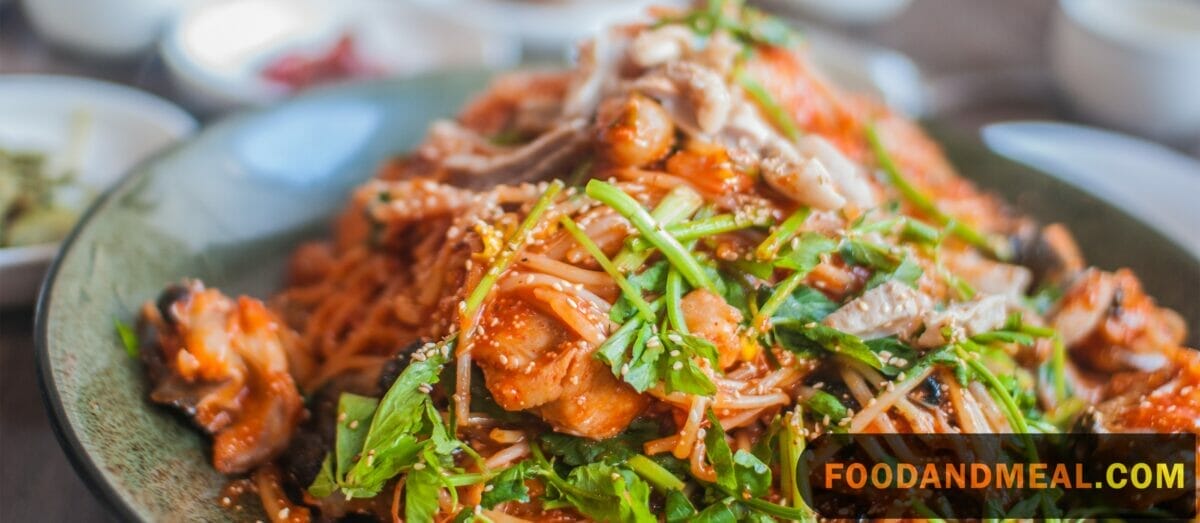
- What does monkfish taste like? Monkfish boasts a mild, sweet flavor and has a firm, meaty texture. Its taste is often compared to lobster or scallops.
- What is monkfish in Korea? In Korea, monkfish is known as “agu” or “agwi.” It is a popular seafood choice and is often used in various Korean dishes, including stews and soups.
- What is the meaning of Maeuntang? Maeuntang refers to a Korean spicy fish stew. It typically features a variety of fish, vegetables, and seasonings to create a flavorful and spicy broth.
- What is a Korean anglerfish dish? Korean anglerfish dish, known as “Agwi Maeuntang,” is a spicy stew made with anglerfish. It includes a medley of vegetables, seasonings, and, in this case, monkfish, resulting in a deliciously fiery and aromatic soup.
- What’s the ideal type of monkfish for this stew? While any fresh monkfish will do, I recommend using the tail meat. It’s meatier and has a firmer texture that holds up well to the robust flavors of the stew. Just ensure that it’s properly cleaned and deboned.
- I’m not a fan of too much spice. Can I adjust the heat? Absolutely! Korean cuisine is all about personalizing to your taste. Feel free to reduce the amount of chili flakes or paste in the recipe. Remember, it’s always easier to add more spice later than to try and mellow it down.
- Can I use other fish or seafood instead of monkfish? Monkfish is traditionally used because of its firm texture and mild flavor. However, if you’re feeling adventurous or can’t source monkfish, you can use alternatives like cod, halibut, or even shrimp. Just adjust the cooking time accordingly.
- How long can I store the leftover stew? Stored in an airtight container, the Spicy Monkfish Stew should last for up to 2-3 days in the refrigerator. Before reheating, give it a good stir and ensure it’s heated thoroughly.
- Can I prepare some components of the stew in advance? Yes, indeed! You can prepare the broth or even the spice mix a day in advance. Store it in the fridge and then combine with the fish and other ingredients when you’re ready to cook. It can make the actual cooking process a breeze, especially if you’re hosting.
Conclusion
As I reflect on my latest cooking adventure with this Spicy Monkfish Stew, warmth and contentment fill my soul. The aromatic broth transported me back to my childhood, conjuring nostalgic memories of sharing seafood stews with my family. At the same time, I felt pride in infusing this traditional dish with my own creative touches.
The monkfish chunks soaked up the dynamic blend of spices and tomato broth beautifully, resulting in a comforting, soul-satisfying meal. As I hoped, the stew struck the perfect balance between gentle heat and deep, layered flavors. Garnishing with fresh cilantro and serving over rice amplified the flavors even further.
I’m thrilled to have brought this taste of home to Food And Meal readers today. My wish is that through cooking this Spicy Monkfish Stew, you’ll connect with your own cherished food memories while also embracing culinary creativity. As you gather around the table with loved ones, may the stew’s warmth fill your bellies and its spices spark lively conversation. Please visit www.foodandmeal.com for the full recipe details to begin your own flavor voyage today!
Hi! I'm Nazia of ‘Nazia Cooks’, a self-taught baker and cook residing in Chennai. Rooted in the rich South Indian culinary landscape, my palate has expanded to embrace global flavors. I revel in crafting fusion dishes, melding traditions to birth unique tastes.



